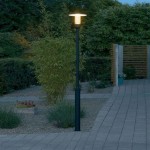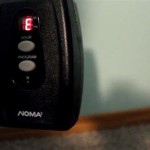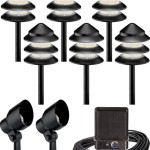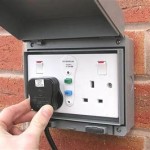Enhancing Safety and Security: A Comprehensive Guide to Garage Outdoor Lights
Garage outdoor lights serve a vital function in enhancing the safety, security, and aesthetics of a property. Adequate illumination around the garage area deters potential intruders, prevents accidents, and improves visibility for nighttime tasks. Selecting the appropriate type of lighting, considering placement strategies, and understanding energy efficiency options are crucial components of a well-designed garage outdoor lighting system. This article provides a comprehensive guide to understanding the various aspects of garage outdoor lighting, enabling informed decisions regarding implementation and maintenance.
Understanding the Benefits of Garage Outdoor Lighting
The advantages of installing outdoor lighting around a garage extend far beyond mere illumination. The most prominent benefits are security enhancement, improved safety, and enhanced curb appeal.
Enhanced Security: Well-lit areas are less appealing to criminals. Darkness provides cover, making a poorly lit garage an easy target for theft or vandalism. Strategically placed lights can deter unwanted activity by removing the cloak of darkness. Motion-sensor lights are particularly effective as they activate upon detecting movement, drawing attention to the area and potentially scaring off intruders. Additionally, visible security cameras paired with adequate lighting provide clear footage, which can be crucial in identifying and apprehending criminals.
Improved Safety: Navigating driveways and walkways in the dark presents safety hazards, especially for individuals with mobility issues or when carrying items. Garage outdoor lights eliminate tripping hazards and reduce the risk of falls. Clear visibility is also crucial for safely operating vehicles in and out of the garage, preventing collisions with objects or pedestrians. Illuminating steps, uneven surfaces, and potential obstacles significantly reduces the likelihood of accidents.
Enhanced Curb Appeal: Lighting can dramatically improve the aesthetic appeal of a property, particularly at night. Well-chosen garage outdoor lights can highlight architectural features, landscaping, and the overall design of the home. The warmth and inviting glow created by strategically placed lights contribute to a welcoming atmosphere, enhancing the perceived value and attractiveness of the property. Different lighting styles, such as spotlights, pathway lights, and wall-mounted fixtures, can be combined to create a visually appealing and functional outdoor lighting design.
Selecting the Right Type of Garage Outdoor Lights
Numerous types of outdoor lighting options are available, each possessing unique characteristics and suitability for specific applications. Considering factors such as brightness, energy efficiency, and lifespan is paramount when selecting the right type of lighting for a garage.
LED Lights: Light Emitting Diodes (LEDs) have become the industry standard for outdoor lighting due to their exceptional energy efficiency, long lifespan, and durability. LEDs consume significantly less energy than traditional incandescent or halogen bulbs, resulting in lower electricity bills. They also last much longer, reducing the frequency of bulb replacements. Furthermore, LEDs are resistant to shock and vibration, making them ideal for outdoor environments. LEDs are available in a wide range of color temperatures, allowing for customization of the lighting ambiance. They can also be easily integrated into motion-sensor and smart lighting systems.
Halogen Lights: Halogen lights offer a brighter light output compared to incandescent bulbs, making them suitable for areas requiring high visibility. However, they are less energy-efficient than LEDs and have a shorter lifespan. Halogen bulbs also generate more heat, which can be a safety concern in certain applications. While some halogen options remain available, LEDs are generally the preferred choice due to their superior performance and energy efficiency.
Solar Lights: Solar-powered lights harness energy from the sun to illuminate outdoor areas. They are an environmentally friendly and cost-effective option for areas where wiring is difficult or impractical. Solar lights require no external power source, eliminating the need for electrical connections and reducing electricity costs. However, their performance is dependent on sunlight exposure, and their brightness may be limited compared to other lighting options. Solar lights are best suited for accent lighting or low-intensity illumination. Improvements in solar technology have led to more efficient and brighter solar lights, but they still may not be sufficient for high-security applications.
Motion-Sensor Lights: These lights are equipped with sensors that detect movement, automatically turning on the light when someone approaches. Motion-sensor lights are an excellent deterrent to intruders and can also improve safety by illuminating walkways and driveways when needed. They can be adjusted to control the sensitivity and duration of illumination, optimizing their effectiveness. Motion-sensor lights can be integrated with various types of light bulbs, including LEDs and halogens, allowing for customization of the light output and energy efficiency.
Strategic Placement and Installation of Garage Outdoor Lights
The effectiveness of garage outdoor lights is heavily dependent on their strategic placement and proper installation. Careful consideration should be given to the areas requiring illumination, the desired level of brightness, and the overall design of the lighting system.
Above the Garage Door: Installing lights above the garage door provides general illumination for the driveway and surrounding area. This placement is ideal for enhancing visibility when entering or exiting the garage, and for deterring intruders. Wall-mounted fixtures or spotlights can be used to create a balanced and visually appealing lighting effect. Ensure that the lights are positioned at a height that provides adequate coverage without creating glare.
Along Walkways and Driveways: Pathway lights or bollard lights can be installed along walkways and driveways to guide visitors and improve safety. These lights should be spaced evenly to provide consistent illumination and prevent tripping hazards. Low-voltage lighting systems are a popular choice for pathway lighting, as they are energy-efficient and easy to install. Consider using lights with downward-facing beams to minimize light pollution and focus the illumination on the pathway.
Near Entry Points: Illuminating entry points, such as side doors or back doors, is crucial for security. Well-lit entry points reduce the risk of break-ins and improve visibility for residents and guests. Install motion-sensor lights or traditional fixtures with timers to ensure that these areas are adequately lit during nighttime hours. Consider using lights with protective cages or vandal-resistant materials to prevent damage or theft.
Corner Illumination: Placing lights at the corners of the garage, and the wider property, is an effective way to eliminate blind spots and deter intruders. Corner lights provide a wide field of illumination, covering a larger area and enhancing overall security. Floodlights or spotlights can be used to highlight the corners of the property and create a sense of security. Strategic corner lighting, combined with other lighting elements, creates a comprehensive security perimeter.
Professional Installation: While some garage outdoor lighting projects can be undertaken as DIY projects, it is often advisable to hire a professional electrician for more complex installations. A professional electrician can ensure that the wiring is installed correctly, that the lights are properly grounded, and that the system meets all applicable safety codes. Improper wiring can pose a fire hazard and may void warranties. Professional installation also ensures that the lights are positioned optimally for maximum effectiveness.
Avoiding Light Pollution: When planning garage outdoor lighting, it is important to minimize light pollution and be considerate of neighbors. Use shielded fixtures that direct light downward, preventing it from spilling into the sky or neighboring properties. Choose bulbs with lower lumen outputs to reduce excessive brightness. Consider using timers or dimmers to control the intensity and duration of the lighting. Being mindful of light pollution helps to create a more pleasant environment for everyone.
Maintenance and Energy Efficiency Considerations
Regular maintenance and a focus on energy efficiency are essential for maximizing the lifespan and minimizing the operating costs of garage outdoor lights.
Regular Cleaning: Outdoor lights are exposed to the elements, and can accumulate dirt, dust, and debris. Regular cleaning will help to maintain their brightness and prevent damage. Use a soft cloth and mild detergent to clean the fixtures. Avoid using abrasive cleaners or harsh chemicals, as they can damage the finish. Cleaning the lights at least a few times a year will help to ensure optimal performance.
Bulb Replacement: Even with long-lasting LEDs, bulb replacement will eventually be necessary. When replacing bulbs, choose the correct type and wattage for the fixture. Follow the manufacturer's instructions for safe bulb replacement. Consider upgrading to more energy-efficient bulbs whenever possible. Proper bulb selection can help to extend the lifespan of the fixture and reduce energy consumption.
Timer and Sensor Adjustments: Periodically review the settings on timers and motion sensors to ensure that they are functioning correctly. Adjust the sensitivity of motion sensors as needed to prevent false alarms. Adjust the timer settings to reflect changes in daylight hours. Optimizing these settings can help to conserve energy and improve the effectiveness of the lighting system.
Energy-Efficient Practices: In addition to using energy-efficient bulbs, consider implementing other energy-saving practices. Use timers to automatically turn off lights during daylight hours. Use dimmers to reduce the brightness of lights when full illumination is not needed. Consider using smart lighting systems that allow you to control the lights remotely and monitor energy consumption. These practices can significantly reduce energy costs and minimize the environmental impact of garage outdoor lighting.
By carefully considering the factors outlined in this guide, property owners can create a garage outdoor lighting system that enhances security, improves safety, and boosts curb appeal while minimizing energy consumption and maintenance requirements. The right lighting system provides peace of mind and creates a welcoming environment for residents and visitors alike.

Garage Lighting In Austin San Antonio

Tips For Choosing The Right Size Outdoor Wall Lights Home Depot

42 Creative Outdoor Garage Lighting Ideas In 2024 Lights Exterior House

Outdoor Garage Lighting Ideas For Security And Visual Appeal

42 Creative Outdoor Garage Lighting Ideas Lights Design

American Made Indoor Outdoor Barn Lights Steel Lighting Co

Rosykite Outdoor Wall Lights Exterior Modern Outside Sconce Ligh

Most Of Us Have Some Lighting Outside Our House That Comes From Which We Manage Porch L Exterior Lights Garage Outdoor

How To Choose The Best Garage Lighting Inspiration Barn Light Electric

8 Modern Outdoor Garage Lighting Ideas
Related Posts







